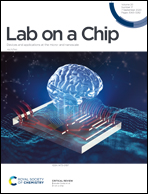Fabrication of vascular smooth muscle-like tissues based on self-organization of circumferentially aligned cells in microengineered hydrogels†
Abstract
Circumferential alignment of vascular smooth muscle cells (vSMCs) is critical to form an in vivo-like vascular smooth muscle layer in vitro. Although many techniques to elicit such an alignment on 3D substrates have been demonstrated, it remains a challenge to recapitulate the circumferential cellular alignment of vascular smooth muscle tissues in 3D hydrogels. Here, we propose a spring-like gelatin methacrylate (GelMA) structure formed by semi-automated reeling of a core–shell microfiber at the micro-scale. The resulting structures facilitate circumferential alignment and self-organization of encapsulated human mesenchymal stem cells (MSCs) into multilayer spring-like cellular structures. Based on the permeable tubular lumens of these structures, a perfusion culture micro-system is developed to further facilitate the vSMC differentiation of MSCs under the effect of TGF-β1. We also evaluated the MSC contraction-induced shrinkage of the resulting cellular structures. These results demonstrate the successful in vitro regeneration of vascular smooth muscle (vSM)-like tissues in 3D environments. Compared with the substrate surface, the porous structure in hydrogels is more similar to cell microenvironments in vivo. Thus, this approach may be used to develop an in vitro model for the study of vascular tissue regeneration and the mechanism of vascular remolding during hypertension.



 Please wait while we load your content...
Please wait while we load your content...